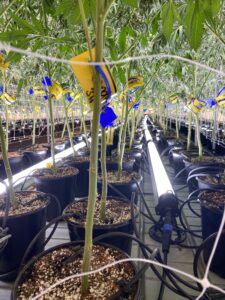
Menu
Menu

Indoor growing is advantageous because it allows year-round cultivation and grants full control over the plant and its environment. Whether living in an apartment or a small house, the flexibility of indoor growth enables one to cultivate cannabis virtually anywhere, even without a backyard or significant extra space.
Indoor Space Designate a specific space for the marijuana plants, ideally near a window for effective ventilation. While grow tents are popular, they are not mandatory, and various spaces such as closets, cabinets, spare rooms, or corners in unfinished basements can suffice. Opting for a smaller setup initially can reduce costs and mitigate potential beginner errors.
Indoor Climate Monitoring and regulating temperature, humidity, light intensity, and airflow are crucial for maintaining an optimal environment for cannabis growth. External climate conditions can influence the grow space, necessitating the use of additional equipment like dehumidifiers or heaters for climate stabilization.
Lights Controlling the lighting cycle is essential for cannabis cultivation. Providing 18 hours of light during the vegetative stage and 12 hours during flowering triggers the growth and budding phases. Ensuring a light-tight space is vital to prevent light leaks that may disturb the plant’s development.
HID Lights High-intensity discharge lights (HID) are widely used for their high output and efficiency, with metal halide (MH) for vegetative growth and high-pressure sodium (HPS) for flowering. Ballasts, hoods, and reflectors are essential components, and air-cooled reflector hoods are recommended to manage the heat generated by these lights. Just like our HID grow lights here >>
Fluorescent Lights Although less efficient than HID lights, fluorescent lights are popular among small-scale growers due to their affordability, included components, and minimal heat generation. However, they produce relatively less light per watt of electricity used.
LED Grow Lights
LED technology continues to advance, boasting enhanced efficiency over time. Despite their higher cost compared to HID setups, LED grow lights offer numerous advantages. They have prolonged lifespans, consume less electricity, emit less heat, and generate a fuller spectrum of light, resulting in higher yields and superior quality cannabis. Check Grow Pros Solutions LED grow lights>>
A continuous flow of fresh air is essential for plant health and the photosynthesis process, which requires an adequate supply of carbon dioxide (CO2). To maintain optimal air circulation, install an exhaust fan to remove warm air from the top and a port or passive fan at the bottom to bring in cool air. Proper airflow prevents humidity fluctuations and CO2 depletion, both detrimental to plant growth. More info>>
Incorporate oscillating fans in your grow room to promote a steady breeze, reinforcing the plants’ stems and overall health. Use clip-on fans for smaller spaces and tents, while medium-sized oscillating fans or large floor models are suitable for larger grow rooms. Position the fans strategically to ensure uniform airflow without directly blowing air onto the plants, which can cause leaf damage.
For excessive humidity, invest in a dehumidifier, but be mindful that it may raise the temperature, necessitating additional fans or an AC unit. Creating the ideal climate often requires multiple equipment pieces, contributing to the higher costs associated with indoor cannabis cultivation. Prioritize fans before considering an AC unit. More info>>
Utilize timers for consistent lighting schedules, ensuring the plants receive the necessary light for each growth stage. A thermostat can regulate the fans based on temperature fluctuations, while environmental controllers automate the entire process, allowing remote management of various devices, including fans, dehumidifiers, humidifiers, heaters, or air conditioners.
Maintain temperatures between 70-85°F during light hours and 58-70°F during off hours, adjusting based on the cannabis variety and growth stage. Control temperature and humidity to create an optimal environment, considering the interconnected relationship between the two and their impact on plant health. Regular monitoring and adjustment are necessary to maintain a stable indoor growing environment. More info>>
Use a thermometer, hygrometer, and an optional infrared thermometer to track temperature and humidity levels in your indoor cannabis setup.
Regulating Temperature
Manage temperature through lighting adjustments, optimal airflow, air conditioners, and heaters as needed for your indoor grow room.
Cold Tolerance of Weed Plants
Weed plants can slow down growth and potentially freeze when temperatures drop below 50°F.
Controlling Humidity
Control humidity with dehumidifiers, proper airflow, humidifiers, and occasional misting for moisture adjustment in your marijuana grow room.
Choosing Soil and Other Growing Media
Opt for traditional soil or other media options like rockwool and hydroponic trays, ensuring nutrient-rich, well-draining soil for healthy plant growth.
Soil Temperature Management
Maintain soil temperatures within the 65-75°F range, ensuring a suitable environment for cannabis plants under grow lights.
Hydroponics
While hydroponics allows for direct nutrient access and potentially larger yields, successful indoor cannabis growth can be achieved using traditional soil and pots.
Select the appropriate container type based on your grow medium and system. Options range from standard plastic pots to more advanced fabric or ceramic containers. More info>>
Container Size Selection
Start with a one-gallon pot, then consider moving to a larger size as your plants grow. Opt for five-gallon, seven-gallon, or ten-gallon pots depending on the plant’s development.
Container Features
Ensure your container offers proper drainage, oxygen exposure, nutrient availability, and sufficient space for healthy root development.
Plastic Containers
Cost-effective plastic pots provide essential functionalities for cannabis plants, although they might lack durability and insulation against temperature fluctuations.
Fabric Containers
Fabric pots promote dense root systems and improved airflow but require diligent maintenance due to quick drying.
Ceramic Containers
Terra cotta pots are suitable for hot climates, offering moisture absorption and cooler temperatures, but drilling holes for drainage can be labor-intensive.
Regularly monitor your plants’ environmental conditions, especially during the delicate stages of clones or seedlings. Adjust temperature and humidity levels accordingly, checking on them every 2-3 days as they grow. More info>>
Watering and Nutrients for Weed
Use clean, drinkable tap water for your plants and monitor it with an EC meter. Maintain the water temperature between 65-75°F to prevent shocking the plant. Check the pH and add appropriate nutrients every other watering session.
Daily Maintenance Checklist
Regularly water plants, check pH levels, inspect for pests or mold, and ensure proper equipment function. Adjust lighting, temperature, and humidity levels as needed.
Marijuana Growth Timeline
Expect 10-32 weeks (3-8 months) for growth, varying based on plant size and desired harvest frequency. Control plant size by transitioning to the flowering stage according to your preference during the vegetative phase.
Odor Control in Indoor Grows
Manage temperature and humidity to control odor. Utilize air circulation systems like fans and ventilation to reduce odors. Odor-absorbing gels and activated carbon filters can help mitigate strong smells during the flowering phase.

Grow Pros Solutions is the NOW for Horticultural Science & Engineering. Grow Pros Solutions is one of the leading manufacturers of high-performance LED grow lights designed for cannabis cultivation. Our focus is to create top performing lighting solutions and fixtures that enable previously unobtainable and unthinkable results, increasing productivity from 30-60%. Our unwavering commitment to advancing technology and finding more efficient and sustainable solutions has made us a gamechanger for thousands of commercial and home growers.
Enter your email here to confirm your interest
All Rights Reserved by GrowPros Solutions